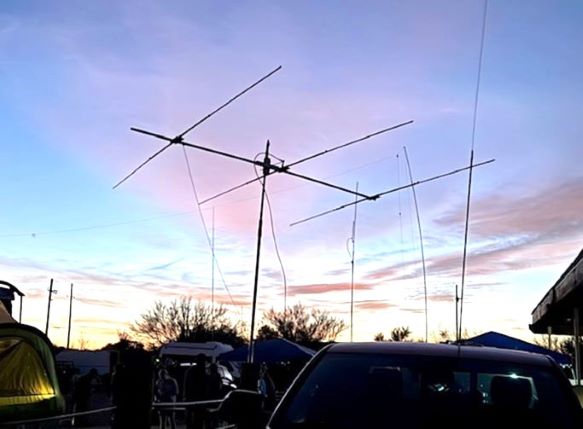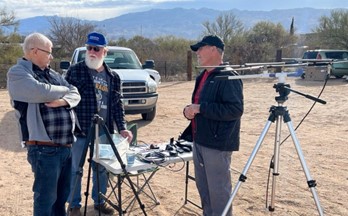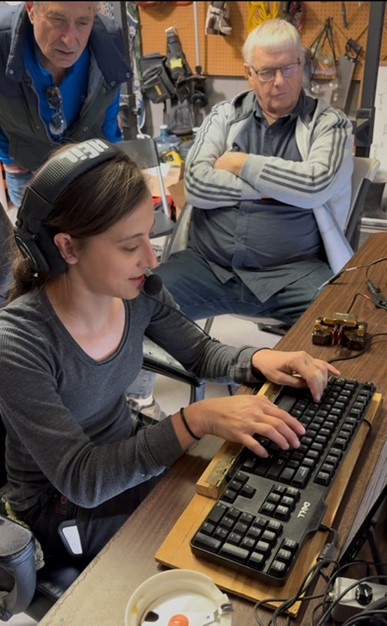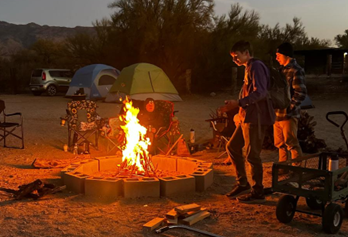
RST participated in Winter Field Day this past weekend, January 24-26.
Our goals for the event were:
- Practice temporary station setup across numerous bands to hone emergency preparedness skills and confirm equipment functionality.
- Create an environment where RST members could develop and enhance structured communications skills (contesting simulates this to some degree).
- Provide teaching/coaching for hams who are new at this type of operation.
- Provide an environment for practicing contesting skills for those that aspire to “high rate” contesting.
- Try out some technologies in which we have limited experience.
- Create a welcoming and fun venue for members to enjoy the “harsh winter conditions” of Tucson.
The event was a great success on all counts.
Much preparation was done in advance of the event to get gear ready, but the weekend effort began on site Friday morning to set up antennas and stations. The three primary stations were:
- 10m station in the “barn” with a 3 element Yagi and multiband Butternut vertical. The radio was a Yaesu FT991a provided by Lloyd K7NX. This station performed very well making by far the most contacts of the event, mainly by our newest crack operator, Helen KE2BPY. Band conditions were somewhat limited on other bands, presumably due to the sun’s helpful CME that occurred Friday night, but 10m seemed in better shape than the others. Also, Helen is just good at it! Other ops contributing at this station were: Lloyd K7NX, Ray NH6NS, Steve KK7GPR, Charlie N7OMI, Don KK7WBH, Ken N7NBV.
- 80m/20m station in the N7DZ trailer with an 80m EFHW at 40+ feet, and a Hy-Gain AV-640 multiband vertical. The radio was an Elecraft KX3 paired with a KXPA100 amplifier provided by Bill N7DZ. The Elecraft pair were pre-owned and recently acquired, and it was a great test of that gear, which performed flawlessly. Both antennas worked well but 20m activity was a bit less than expected, again, we suppose due to the CME. Many members dropped in to visit and operate or observe or get some introduction to the use of the logging software.
- 40m/15m station in Ken’s guest house with a G5RV wire antenna. The radio was a Kenwood TS570 provided by Richard K7NSW. This station had many visitors (the most roomy and comfortable). Numerous members interacted with Richard about the equipment, logging, Morse Code and keys. Richard did the operating.

In addition, there were the following stations for shorter periods:
- Julian KK7PKA operating 20m with his own gear under shade outside. The N7DZ trailer was off the air during this period.
- Joe K3TYE supervising Scout Troop 157 operators made some contacts on 2m simplex.
- The satellite station was set up in the open with an FT991a listening to the 70cm downlink and a TidRadio TD-H3 transmitting the 2m uplink, both connected to an Elk Antennas 2m/70cm dual-band log-periodic antenna, with a diplexer separating the bands. Main contributors to this station were Lloyd K7NX, John AI7AZ, Paul KK7MOK, with Helen Ke2BPY providing the compelling voice for the CQ.
These stations provided the environment for goals 1 to 4 above, and the brief descriptions give a hint of how those goals were achieved.
As for #5, the novel technologies goal, we tried two operation modes with which we had little or no experience.
Our group put a great effort into learning (beginning to learn anyway) about Amateur Radio satellite communications prior to the weekend. How the cross band full duplex signaling works, what antennas and radios are needed, how to aim the antenna, and procedures during the brief satellite crossing are all somewhat complex issues. Paul, KK7MOK, and John, AI7AZ along with Lloyd K7NX lead the effort, with several volunteer satellite tracking antenna pointers helping. The team came “close” a few times: hearing several CQ calls, and once, hearing our own echo back from the satellite, but alas, no one responded to Helen’s, KE2BPY, CQ.
We also configured the barn station for a digital HF mode that supports passing email from locations where cell phone service is unavailable, a system called WinLink. Modem and management software runs on a radio connected PC. The software automatically controls the radio to run through a list of WinLink servers until it finds one with an adequate signal to make the connection, then passes queued email up and down the link. This is a particularly interesting technology with respect to emergency communications from disaster areas, where other access to email may be impossible. The WFD rules provide a bonus multiplier for passing a WinLink message, and we achieved that goal.
Goal #6 maybe was the best of all. With tremendous support from Scout Troop 157 we had warm meals provided from an open-air kitchen for coffee all day, breakfast, lunch, and dinner Saturday, and even Dutch Oven peach cobbler Saturday night. There was a great campfire gathering Saturday night. And the youthful and playful presence of the Scouts enlivened the atmosphere for everyone. In addition, it was great to see so many of our members in happy conversations, taking walks together or standing in small groups chatting. It was clearly an environment where much happy social interaction took place.
And because I like numbers, here’s a summary of that part of the event.
Total QSOs: 700 across 80, 40, 20, 15, 10, and 2, 209 CW, 491 phone.
By band & mode:
- 80m: 47 CW
- 40m: 1 CW
- 20m: 98 CW, 69 phone
- 15m: 54 CW, 3 phone
- 10m: 9 CW, 412 phone
- 2m: 7 phones
With 2x points for CW, our point base is 909
Multipliers:
- Away from Home = 2
- Deploy multiple antennas = 1
- Send a WinLink message = 1
- Copy the official WFD bulletin = 1
- Operate on at least 6 bands = 6
- Operate multiple modes = 2
- Operate at least 6 consecutive hours = 2
- Total multipliers = 15
Which should yield a final score of 909 x 15 = 13,635 points. Let’s hope they agree.
This RST event was a great success. We had no illusions about getting a high score this time, and that was never the goal. It was more about attracting interest in contesting, practicing skills that would be useful in emergencies, and having some fun. We surely did all of that.
Many people collaborated to make this happen, and thanks are in order. At the risk of omitting someone (but I hope not), here is my attempt at credit where credit is due.
For hosting us at the OK Corral, we’re immensely grateful to the Boyd’s, Ken N7NBV and Vicki KG7OYY. Their property is such a good venue for winter outdoor radio activities, and their generosity in allowing us to set up there is invaluable.
Equipment was provided by many members. Radios, antennas, and ancillary gear from Lloyd K7NX, Bill N7DZ, Ken N7NBV, Richard K7NSW, Julian KK7PKA, John AI7AZ, Paul KK7MOK, Avery WB4RTP, and maybe some others (apologies if so).

The operators were Helen KE2BPY, Lloyd K7NX, Ken N7NBV, Ken KK7MBX, Joe K3TYE, Ray NH6NS, Steve KK7GPR, Charlie N7OMI, Don KK7WBH, Bill N7DZ, Julian KK7PKA, and Richard K7NSW.
Apologies again if I omitted someone.
A couple of “bonus” activities included Joe, K3TYE providing a telescope for some great viewing of almost all the planets, and a few other interesting night objects. Ken, N7NBV provided his Royal Enfield + Sidecar (Single Sidecar Band?) for photos and an “exciting” ride around the corral for those scouts who had permission.
The attendance log is below.
Thanks to all who made it happen and came to participate.
We look forward to the next one.
The Contesting and Special Event SIG
Bill N7DZ, Lloyd K7NX, Helen KE2BPY, Ken N7NBV
2025 RST Winter Field Day Attendance Log
- N7NBV, Ken
- AI7AZ, John
- KK7YDD, Peter
- KK7WBH, Don
- KK7GPR, Steve
- K3TYE, Joe
- K7HJ, George
- KK7MOK, Paul
- K7NX, Lloyd
- NH6NS, Ray
- KE2BPY, Helen
- N7DZ, Bill
- KK7JDE, Andrew
- KK7OLN, Cameron
- W6JSD, Jim
- KK7PKA, Julian
- KD7HZQ, James
- W0PSN, Kirk
- K7NSW, Richard
- N7OMI, Charlie
- KK7PCZ, Dennis
- K6WSC, Bill
- KK7MBX, Ken
- KK7JDF, Michael
- KK7JDG, Nicholas
- W7RFL, Robert
- WB4RTP, Avery

Reported by Bill N7DZ
Uploaded by Ana WV3RSE